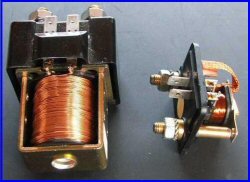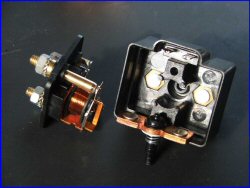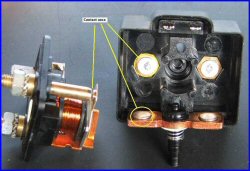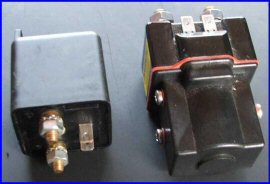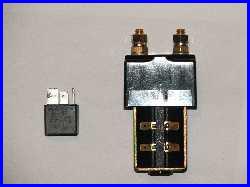More on relays used for split charging purposes
It is not often appreciated how the ratings on relays can be, er.... shall we say misinterpreted?
For instance you may see a relay rated at 180 amps, yet it looks substantially smaller, and weedier, than a competitor's 180 amp relay. The reason can be stated in one of two ways. Either the company is using a different rating system, or they are not being totally honest.
It really is that simple. 180 amps? for how long? for 10 seconds? 10 minutes? indefinitely?
Unfortunately this "misunderstanding" can have rather serious implications. Suppose you work out that you need a relay capable of handling 150 amps for your split charge system. You buy one rated at 180 amps and feel safe. You have built in a margin of safety. Unless the relay really is a genuine 180 amp relay the consequences could be a very short relay life or even, in extreme circumstances, a fire. Obviously something needs to be done about this.
The relays we use are supplied by a very reputable UK company. They are manufactured in the UK to very strict standards and, in our own tests, greatly exceeded the ratings given by the manufacturer.
Many relays come from the far east. Now whilst some of these are very good, some of them are not.
|
Take a look at the photo on the right. The relay on the left is one of our UK manufactured 100 amp relays. The one on the right is a far eastern relay. The rating on it states "12 volt 180 amp". How come our 100 amp relay is over twice the size of the other so called 180 amp relay?
Because our relay really is 100 amps. The other relay really isn't 180 amps. That is why.
It's simple really.
|
|
|
|
|
|
In this photo I've dismantled both relays. The piece on the right hand side is the contact section from our 100 amp relay. The part on the left is the entire inside of the so called 180 amp relay.
Look at the difference in the size of the actual contacts.
|
|
|
This photo shows the actual contact areas of each relay. The relay on the right has a contact area approximately 3 times wider thus giving a contact area about 9 times larger than the relay on the left. Yet according to the ratings it only has half the current carrying capacity.
All other things being equal. The contact area is the defining factor in the current carrying capability of a relay. However even the conductors in our 100 amp relay are much thicker than in the other so called 180 amp relay.
|
|
|
|
|
|
And here are the complete assembled units.
You may recognise the relay on the left. Despite it's rating of 180 amp, most people in the know consider these to be a 50 amp relay. Because anything higher than this tends to destroy them very quickly.
The relay on the right is more than adequate to handle even starter currents. Infact the SmartGuard uses the latching version of this relay in vehicles and the starter current is drawn through this relay every time the vehicle is started.
|
|
The so called 180 amp relay is of far eastern manufacture and is a very commonly seen relay used for split charging on vehicles and boats. Not surprisingly, they fail very often. They are simply not up to the job of operating at heavy charge and discharge currents.
We see this relay all the time. It is pitiful. In tests they burn the contacts, become high resistance, which makes even more heat and leads to total destruction of the relay. This happens at 60 amps after about 8 hours.
At 180 amps the relay lasted less than 30 minutes. It generated so much heat that the bolts melted their way through the plastic base. This is obviously highly dangerous considering the amount of current that could flow if they shorted to ground, hull, chassis etc.
Our relay in the above photos was tested by us at 300 amps. It started to get too warm to touch after about 10 hours. And remember this relay is only rated at 100 amps by the manufacturer.
There is really no comparison between these 2 relays. Just looking at them is sufficient to tell the difference.
Yet the price of the far eastern one is typically around £15.00 in the UK. Our 200 amp relay (not in the photograph) is twice this price. But if our 100 amp relay is so much better imagine what the 200 amp unit is like.
Even this 100 amp relay is far more substantial than the other so called 180 amp relay.
|
And finally, for a real laugh, here is a photo of a so called 70 amp relay that many installers use for split charging purposes next to our SW180-2 200 amp relay.
Seriously, we do see that little relay used for split charging.
Some people install that little thing then wonder why their split charge system fails.
There isn't any need to say anything more.
|
|
|
Web site and all contents Copyright SmartGauge Electronics 2005, 2006, 2007, 2008. All rights reserved.
Page last updated 02/04/2008.
Website best viewed on a computer of some sort.
